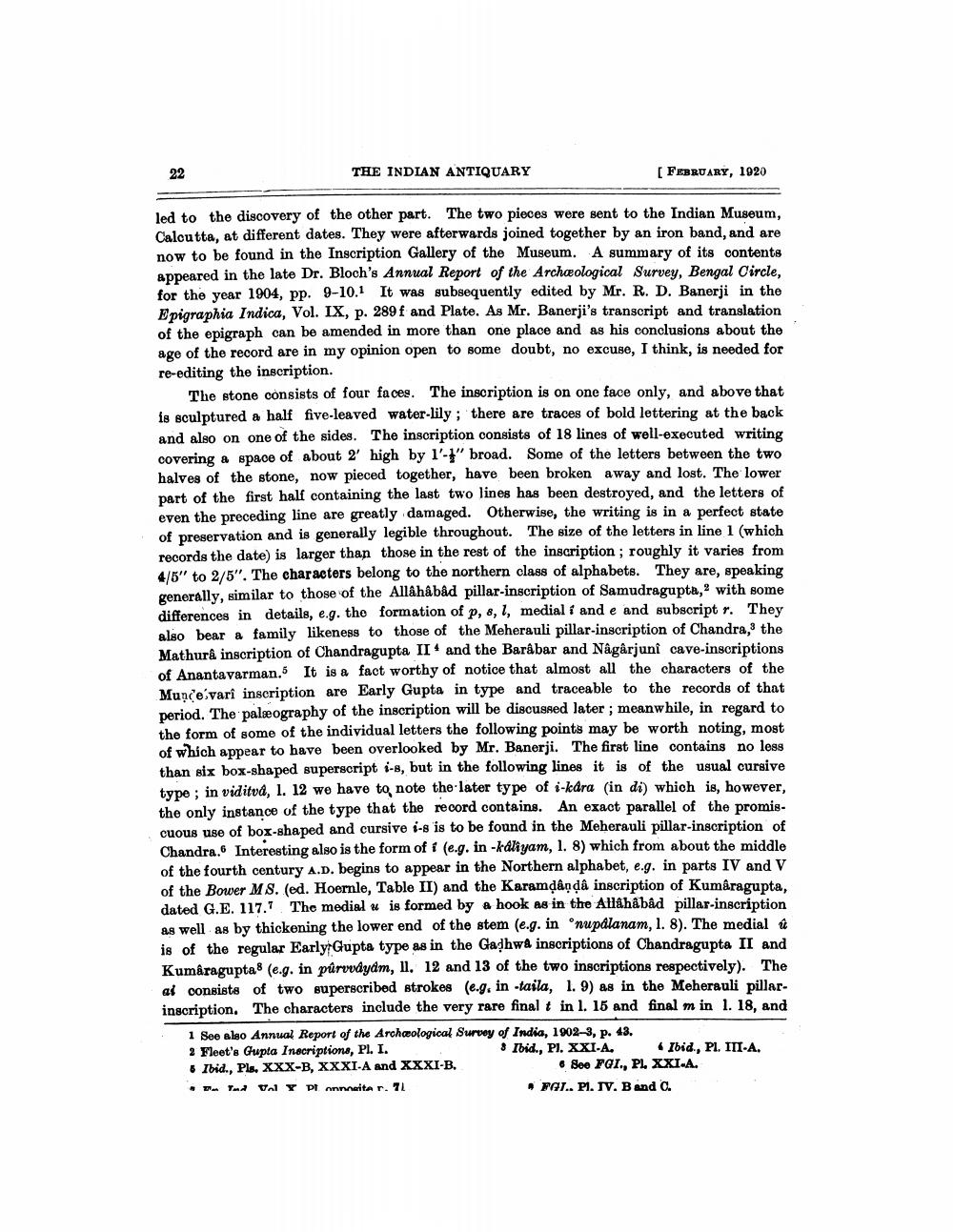________________
22
THE INDIAN ANTIQUARY
[ FEBRUARY, 1020
led to the discovery of the other part. The two pieces were sent to the Indian Museum, Calcutta, at different dates. They were afterwards joined together by an iron band, and are now to be found in the Inscription Gallery of the Museum. A summary of its contents appeared in the late Dr. Bloch's Annual Report of the Archaeological Survey, Bengal Circle, for the year 1904, pp. 9-10.1 It was subsequently edited by Mr. R. D. Banerji in the Epigraphia Indica, Vol. IX, p. 289f and Plate. As Mr. Banerji's transcript and translation of the epigraph can be amended in more than one place and as his conclusions about the age of the record are in my opinion open to some doubt, no excuse, I think, is needed for re-editing the inscription.
The stone consists of four faces. The inscription is on one face only, and above that is sculptured a half five-leaved water-lily; there are traces of bold lettering at the back and also on one of the sides. The inscription consists of 18 lines of well-executed writing covering a space of about 2' high by 1-1" broad. Some of the letters between the two halves of the stone, now pieced together, have been broken away and lost. The lower part of the first half containing the last two lines has been destroyed, and the letters of even the preceding line are greatly damaged. Otherwise, the writing is in a perfect state of preservation and is generally legible throughout. The size of the letters in line 1 (which records the date) is larger than those in the rest of the inscription ; roughly it varies from 4/5" to 2/5". The characters belong to the northern class of alphabets. They are, speaking generally, similar to those of the Allâhâbåd pillar-inscription of Samudragupta, with some differences in details, e.g. the formation of p, 8, l, medial i and e and subscript r. They also bear a family likeness to those of the Meherauli pillar-inscription of Chandra, the Mathura inscription of Chandragupta II and the Barabar and Nagarjuni cave-inscriptions of Anantavarman. It is a fact worthy of notice that almost all the characters of the Munce vari inscription are Early Gupta in type and traceable to the records of that period. The paleography of the inscription will be discussed later ; meanwhile, in regard to the form of some of the individual letters the following points may be worth noting, most of which appear to have been overlooked by Mr. Banerji. The first line contains no less than six box-shaped superscript i-s, but in the following lines it is of the usual cursive type : in viditvd. l. 12 we have to note the later type of i-kara (in di) which is, however, the only instance of the type that the record contains. An exact parallel of the promiscuous use of box-shaped and cursive i-s is to be found in the Meherauli pillar-inscription of Chandra. Interesting also is the form of (e.g. in -kaliyam, 1. 8) which from about the middle of the fourth century A.D. begins to appear in the Northern alphabet, e.g. in parts IV and V of the Bower MS. (ed. Hoernle, Table II) and the Karamţândâ inscription of Kumâragupta. dated G.E. 117. The medial # is formed by a hook as in the Allahâbâd pillar-inscription as well as by thickening the lower end of the stem (e.g. in 'nupdlanam, 1. 8). The medial i is of the regular Early Gupta type as in the Gadhwa inscriptions of Chandragupta II and Kumâragupta (e.g. in púrvvdyam, 11, 12 and 13 of the two inscriptions respectively). The ai consists of two superscribed strokes (e.g, in-taila, 1. 9) as in the Meherauli pillarinscription. The characters include the very rare final t in l. 15 and final m in 1. 18, and
1 See also Annual Report of the Archeological Survey of India, 1902-3, p. 43. 2 Fleet's Gupta Inscriptions, PI. I.
Ibid., PI. XXIA. Ibid., PI, III-A. 6 Ibid., Pls. XXX-B, XXXI-A and XXXI-B.
See FQI., PL, XXI.A. . Ted VA Y Panneita r. 7
• FGL. P. IV. B and C.




